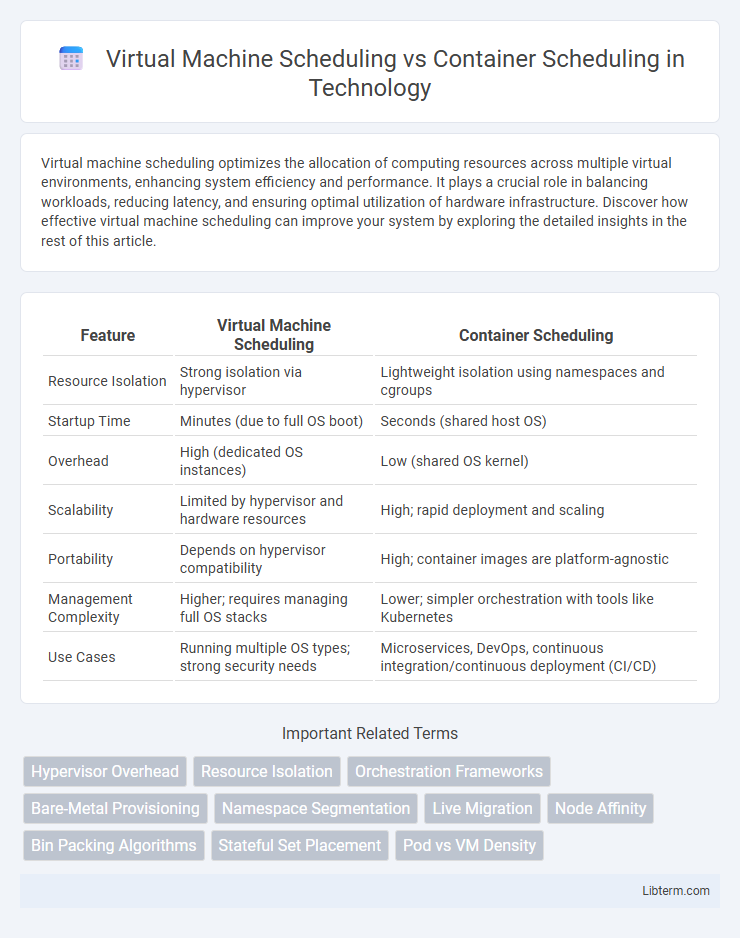Virtual machine scheduling optimizes the allocation of computing resources across multiple virtual environments, enhancing system efficiency and performance. It plays a crucial role in balancing workloads, reducing latency, and ensuring optimal utilization of hardware infrastructure. Discover how effective virtual machine scheduling can improve your system by exploring the detailed insights in the rest of this article.
Table of Comparison
| Feature | Virtual Machine Scheduling | Container Scheduling |
|---|---|---|
| Resource Isolation | Strong isolation via hypervisor | Lightweight isolation using namespaces and cgroups |
| Startup Time | Minutes (due to full OS boot) | Seconds (shared host OS) |
| Overhead | High (dedicated OS instances) | Low (shared OS kernel) |
| Scalability | Limited by hypervisor and hardware resources | High; rapid deployment and scaling |
| Portability | Depends on hypervisor compatibility | High; container images are platform-agnostic |
| Management Complexity | Higher; requires managing full OS stacks | Lower; simpler orchestration with tools like Kubernetes |
| Use Cases | Running multiple OS types; strong security needs | Microservices, DevOps, continuous integration/continuous deployment (CI/CD) |
Introduction: Understanding Virtual Machine and Container Scheduling
Virtual Machine scheduling allocates hardware resources through a hypervisor to run multiple isolated VMs on a single physical server, focusing on efficiency and workload isolation. Container scheduling operates at the OS level, managing lightweight, portable containers using orchestrators like Kubernetes to optimize application deployment and scalability. Both scheduling methods aim to maximize resource utilization, but container scheduling emphasizes rapid scaling and minimal overhead compared to traditional VM scheduling.
Core Concepts: Virtual Machines vs Containers
Virtual machines operate by virtualizing hardware to run multiple operating systems on a single physical server, providing isolated environments with dedicated resources through hypervisors. Containers abstract the operating system layer, enabling multiple applications to share the same kernel while maintaining process-level isolation, resulting in lightweight and faster deployment. Core scheduling concepts revolve around resource allocation granularity: virtual machines are scheduled by the hypervisor managing entire OS instances, whereas containers are scheduled by container orchestrators managing individual application workloads within a shared OS.
Scheduling Architecture: Key Differences
Virtual machine scheduling relies on hypervisor-based architecture, where the hypervisor manages physical resources and allocates virtual machines (VMs) accordingly, providing strong isolation and resource abstraction. Container scheduling operates on a container orchestration platform like Kubernetes, which manages container lifecycle and resource allocation at the operating system level, offering lightweight, scalable, and fast deployment. Key differences include VM scheduling's dependence on hardware virtualization and isolation versus container scheduling's utilization of kernel namespaces and cgroups for efficient, shared resource management.
Resource Allocation Strategies
Virtual Machine scheduling allocates resources by partitioning hardware at the hypervisor level, ensuring isolated environments with fixed CPU, memory, and storage quotas, which can lead to unused resource overhead. Container scheduling leverages orchestration platforms like Kubernetes to dynamically assign resources using cgroups and namespaces, enabling more efficient and flexible resource sharing across containers on the same host. This results in higher utilization rates and quicker scaling compared to the heavier isolation model of virtual machines.
Performance and Efficiency Considerations
Virtual machine scheduling involves allocating dedicated resources to each VM, which can lead to overhead from hypervisor management but ensures strong isolation and consistent performance. Container scheduling, by contrast, enables lightweight resource sharing among containers on the same host, improving efficiency and reducing latency but potentially causing contention under heavy workloads. Performance considerations prioritize VM scheduling for heavy, isolated tasks while container scheduling excels in scalability and rapid deployment scenarios.
Scalability in VM and Container Scheduling
Virtual Machine scheduling scales by allocating dedicated resources to each VM, which can limit scalability due to overhead from hypervisor management and resource isolation. Container scheduling achieves higher scalability by sharing the host OS kernel and leveraging lightweight container runtimes, enabling faster provisioning and more efficient use of resources. Kubernetes and Docker Swarm exemplify container schedulers that support dynamic scaling and rapid deployment compared to traditional VM orchestration tools like VMware vSphere or OpenStack Nova.
Fault Tolerance and High Availability
Virtual machine scheduling uses hypervisor-level resource allocation to ensure fault tolerance by isolating failures within each VM, enabling seamless migration and recovery without impacting other VMs. Container scheduling relies on orchestrators like Kubernetes to provide high availability through pod replication and automated rescheduling, but containers share the host OS kernel, which may pose risk during underlying system failures. Fault tolerance in container scheduling improves via health checks and cluster-wide state management, while virtual machines inherently offer stronger isolation and recovery mechanisms due to their encapsulated environments.
Security Implications in Scheduling
Virtual machine scheduling offers stronger isolation by segregating resources at the hypervisor level, reducing the risk of cross-tenant attacks and enhancing security boundaries between workloads. Container scheduling, relying on shared OS kernels, presents higher risks of container escape and privilege escalation, making it crucial to implement rigorous namespace isolation and security policies. Effective security in container scheduling depends on tools like Kubernetes Pod Security Policies and runtime security scanners, whereas VM scheduling benefits from mature hypervisor-based access controls and secure boot mechanisms.
Popular Tools and Platforms Compared
Popular tools for virtual machine scheduling include VMware vSphere, Microsoft Hyper-V, and OpenStack, which offer robust resource allocation, migration, and high availability features. Container scheduling is dominated by Kubernetes, Docker Swarm, and Apache Mesos, which specialize in orchestrating lightweight, portable containerized applications with emphasis on scalability and fault tolerance. Kubernetes leads in container orchestration due to its extensive ecosystem and advanced scheduling algorithms, contrasting with the more infrastructure-focused management capabilities of VM schedulers.
Choosing the Right Scheduling Approach for Your Needs
Virtual machine scheduling allocates resources at the hypervisor level, providing strong isolation and compatibility for diverse operating systems, ideal for workloads requiring security and resource guarantees. Container scheduling operates at the OS level, enabling lightweight, fast, and scalable deployments suited for microservices and dynamic, cloud-native environments. Selecting the appropriate approach depends on factors like workload isolation requirements, resource overhead tolerance, and the need for rapid deployment and scaling.
Virtual Machine Scheduling Infographic

 libterm.com
libterm.com